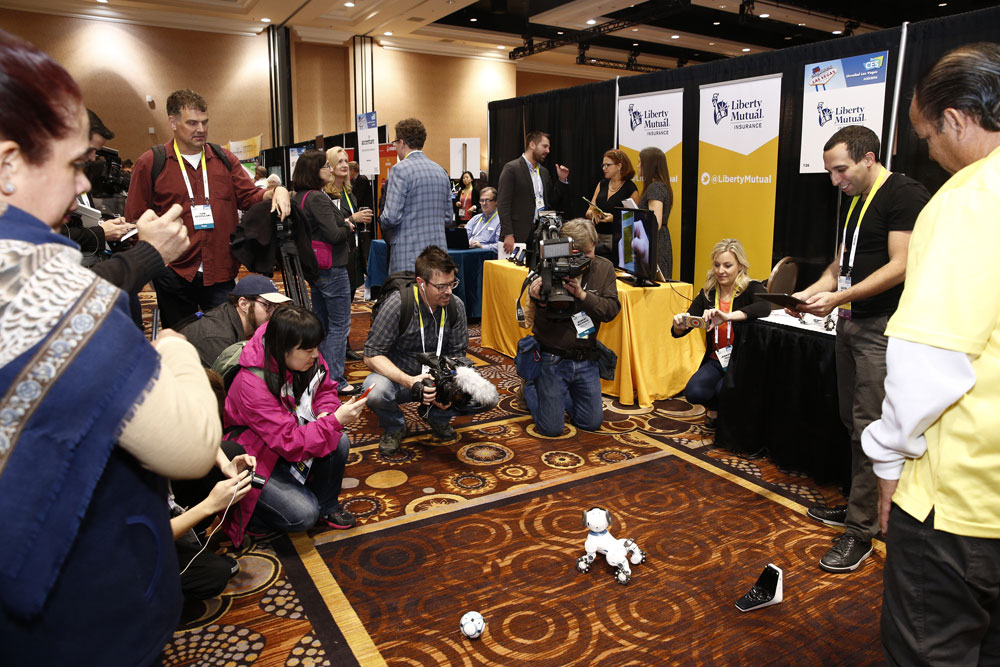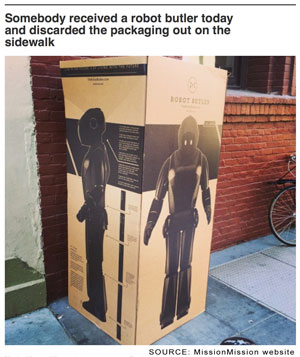
Robohub.org
#CES2016: Noise, hype, hustle … and business as usual

Robots on the show floor of CES Unveiled Las Vegas on January 4, 2016. Source: Consumer Technology Association
CES is truly a global technology event: 3,800 exhibitors (of which 500 were startups); 2.47 million sq feet of exhibit space; 170,000 industry professionals (of which 50,000 were from more than 160 countries, including a Cuban delegation)!
Massive, exhausting, noisy, crowded, colorful, fun
The key words one heard from passers-by and sales people were: smart; connected; robotic; autonomous; self-driving; drones; IoT (Internet of Things); healthcare; fitness; apps; sensors; cameras; China; Taiwan; AI; headsets; virtual reality; augmented reality; and Mercedes Benz’s concept car.
Exhibitors attempted to show products that corresponded to those buzzwords, and visitors were “bombarded with early versions of tomorrow’s tech that are bound to feel janky and incomplete,” said Farhad Manjoo in the NY Times.
 Smart shower heads that reduce water flow when you step away to lather up; smart fridge cameras that send a view of what’s inside your fridge to your smartphone while you’re shopping at the store, or to a flat panel screen on the outside door of the fridge; big TVs (some up to 170″/432cm) with curved screens; virtual reality headsets; panelled lighting arrays; follow-me drones and carriers of all types; ski airbags (similar to boating life vests); Parrot’s new single wing drone (similar to senseFly’s eBee); the new Star Wars BB-8 toy from Sphero; wristband follow-me wearables; every type of workout wearable and sensor; avatars with customized faces (can be your face); pet games and food dispensers; makeup mirrors that overlay on your face different makeup combinations; bi-color LED lights for indoor ag farms; huge walls of TV screens showing every type of spectacular scene; face-tracking cameras; and connected cars and their driving, navigation and entertainment systems.
Smart shower heads that reduce water flow when you step away to lather up; smart fridge cameras that send a view of what’s inside your fridge to your smartphone while you’re shopping at the store, or to a flat panel screen on the outside door of the fridge; big TVs (some up to 170″/432cm) with curved screens; virtual reality headsets; panelled lighting arrays; follow-me drones and carriers of all types; ski airbags (similar to boating life vests); Parrot’s new single wing drone (similar to senseFly’s eBee); the new Star Wars BB-8 toy from Sphero; wristband follow-me wearables; every type of workout wearable and sensor; avatars with customized faces (can be your face); pet games and food dispensers; makeup mirrors that overlay on your face different makeup combinations; bi-color LED lights for indoor ag farms; huge walls of TV screens showing every type of spectacular scene; face-tracking cameras; and connected cars and their driving, navigation and entertainment systems.
The show was organized by areas with sections for 3D Printing, Apps, Augmented Reality, Cyber & Personal Security, eCommerce, Education & Technology, Family & Technology, Fitness & Technology, Gaming & Virtual Reality, HDMI, Health & Wellness, iProducts, Kids & Technology, Robotics, Smart Home, Smart Watches, Sports Tech, Unmanned Systems, Vehicle Intelligence, and Wearables — essentially the whole gamut of electronic consumer products. Fitness, sports tech, vehicles and their systems, all had particularly mammoth areas.
 The biggest exhibit spaces included two Chinese companies: Hisense and TCL. Other super-large exhibition spaces were for Samsung (the absolute biggest), LG, Nikon, Canon, Panasonic, Sony, Mercedes, Intel and Qualcomm.
The biggest exhibit spaces included two Chinese companies: Hisense and TCL. Other super-large exhibition spaces were for Samsung (the absolute biggest), LG, Nikon, Canon, Panasonic, Sony, Mercedes, Intel and Qualcomm.
- Hisense is a Chinese multinational white goods and electronics manufacturer headquartered in Qingdao, Shandong. It is a state-owned enterprise with publicly traded subsidiaries.
- TCL Corporation is a Chinese multinational electronics company headquartered in Huizhou, Guangdong.
The most notable companies NOT exhibiting were Apple, Facebook, Amazon, Google and IBM — although most had hospitality suites and/or meeting rooms for their ad teams to meet with clients who produced consumer electronic products, and IBM’s CEO was one of the keynote presenters (see below).
Business getting done
In a NY Times article, the serious side of the CES spectacle was highlighted:
“A lot of business gets done at CES, often away from the show floor, in the labyrinthine warrens of meeting rooms across the Las Vegas Strip.”
Very true. Even companies that didn’t exhibit (like Twitter and IBM) had quiet spaces to demonstrate products, talk pricing and agreements, and generally have time and space for one-on-ones with customers and prospects. Although IBM is no longer in the consumer products business, they had a large meeting room set aside for their customers who were. Twitter created a miniature city in two large ballrooms at one of the hotels. It had shops, restaurants, a bar, a theatre, and an outdoor park. Each was a meeting area for Twitter’s ad sales team to meet and greet customers.
Hourly press events hyped, but some made news
There were more than 25 press conferences held at the show. Many were announcing additional products to an existing product line. A few described new products. And some, like Toyota and Intel, provided pertinent information about profound changes about to happen.
Toyota held a press conference led by Gill Pratt of DARPA fame, who now is the CEO of Toyota Research Institute (TRI) wherein he announced their new research staff. One member of that staff was James Kuffner, the previous head of Google’s robotics group known as Replicant. His departure continues the robotics shakeup at Google. Details here.
Other press events ranged from entertaining to informative and included Yamaha Ventures announcing their cooperation with SRI International to jointly turn Yamaha’s MotoBot into a real thinking and navigating robot.
“This project will be able to push several boundaries: visualizing data about human motorcycle operation, further quantifying the relationship between rider input and machine behavior, and then using the resulting know-how to build even better vehicles,” explains Amish Parashar, Director of Strategic Business Development at Yamaha Motor Ventures and Laboratory Silicon Valley Inc.
Keynotes were particularly informative
Intel, IBM, Netflix, General Motors and Volkswagen all had keynote presentations, but seats for Intel’s were the most highly prized.
Intel’s CEO Brian Krzanich was the featured speaker and he covered so many topics one really has to watch the whole hour and forty minute presentation to capture the full impact of all that he described. The import of what he said — that we are moving from a time of transactional systems to one that is experiential — seems predictive of the next few years in electronics, the digital world, robotics and artificial intelligence. Watch the video above or read the condensed version here.
IBM’s CEO Ginni Rometty told a packed CES audience that Watson and IBM were changing the nature of data processing from transactional to cognitive and that this process would change computing and lead to providing cognition as a service. IBM describes the cognitive process as providing the 3rd hand for a lab technician, very similar to the experiential descriptor used by Intel’s CEO. During Rometty’s presentation she described how Watson is working with SoftBank to provide global distribution and support for their Pepper robots. Read the condensed version here.
A bit of cynicism: Lots of overzealous hype
 Overzealous marketing can be seen regularly in crowdfunding campaigns. CES was similarly full of examples of ventures claiming to be able to provide something useful when, in fact, they need funding to see whether they can actually do what they are promising. Sometimes these companies hire social media people to help promote those very things using viral marketing in their arsenal of advertising tools. There are many examples — but the 2014 Robot Butler campaign is a paradigm classic.
Overzealous marketing can be seen regularly in crowdfunding campaigns. CES was similarly full of examples of ventures claiming to be able to provide something useful when, in fact, they need funding to see whether they can actually do what they are promising. Sometimes these companies hire social media people to help promote those very things using viral marketing in their arsenal of advertising tools. There are many examples — but the 2014 Robot Butler campaign is a paradigm classic.
A joint marketing campaign for Quirky (which was promoting their array of smart home sensors, switches and products) and subsidiary Wink (which makes a hub that combines them into a smart home) featured a catchy video ad suggesting that smart homes were better served by Wink products than by a robotic butler. The video, entitled Like a robot butler, but less awkward, showed a couple in bed being uncomfortable with their robot butler peeking in on them as if it were sentient. The ad was supported by the distribution of a bunch of cardboard shipping boxes for non-existent robot butlers that were dropped off on the streets of San Francisco waiting for trash pickup as if they were the empty boxes of real robot butlers. The promoters hyped sightings of those boxes with lots of blog posts, tweets and other social media, and even set up a Robot Butler website.
AdWeek finally exposed the situation:
“Well, it turns out this was just a social media sensation. There is no real Robot Butler, at least not this one, and the whole misleading campaign, was just for an app that controls home appliances.
“The company behind the app and marketing was called Wink which is owned by Quirky, a New York-based company that makes Internet-connected devices for the home and other gadgets, and General Electric is an investor in Quirky.
“Quirky is for real and subscribed to Wink’s parody marketing campaign based on the Robot Butler. The problem was there was no indication that the robot was a hoax, it was not selling out of stock as claimed, it would not be ready for shipment to consumers, and it was not being reviewed by reputable news sources.”
Quirky recently filed for bankruptcy; the Wink component is being sold off as IP to Flextronics International; the advertising “parody” (which, in this case, appeared to be a euphemism for “phony”) failed; and a real robot butler is still many years off.
Bottom line:
CES draws huge traffic to the worlds of digital, electronics, robotics, IoT and consumer products. Everyone wants to learn about products and thematic or even paradigm changes that will affect their lives in the near future, and over 6,000 members of the media from all over the world were there to gather that information. Their observations have been — and will be — top news stories for months to come.
There will be mistakes made in some of those reports as there was in a recent NPR story about Pepper costing $20k when actually it sells for $2k. Nevertheless, the CES experience is a valuable stimulant for all of us in the various industries that make up the robotics industry.
The two keynotes by the CEO’s of Intel and IBM shown above describe a trend from transactional to cognitive to experiential. This has import to the robot industry in a variety of ways.
- by IBM’s Watson being incorporated in SoftBank’s Pepper social robots
- by the ever-increasing value of the chips, cameras and systems being offered by Intel, Qualcomm and others
- and by the expectation of users to be able to communicate and be understood by their robotic assistants.
There’s no reason to overdo the promotion of future products by falsification, stealing content or otherwise hyping a product beyond it’s capabilities or possibilities. People read most of the stories and reports coming out of CES because they want facts about products they may want to buy. They want the truth — and they can handle the truth.
tags: c-Events, CES2016, cx-Consumer-Household


